Explaining Bangladeshi cuisine
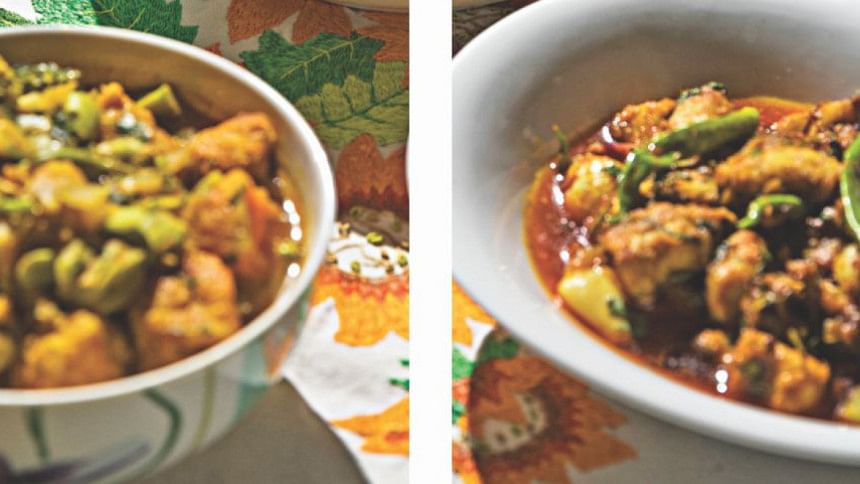
It took time and copious amounts of tea, but listening to her lively and animated stories, made it hard for me to relate to the same woman with the large 'teep' and serious demeanour that I had seen on the telly over the years, cooking up dishes from all regions of Bangladesh.
She started off by taking me back to the many trips that she had made to Chittagong division, with an emphasis on the food of the hill tracts.
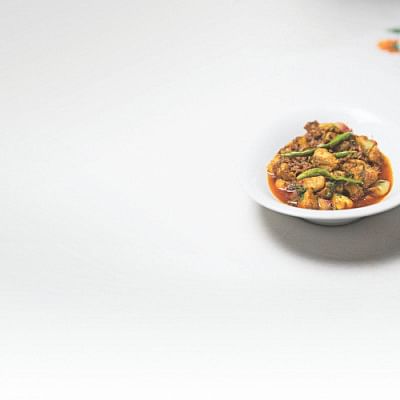
CHITTAGONG HILL TRACTS
Spice wise, ginger and turmeric are staple to recipes in this entire belt. There is a variety of potatoes and taro that grows in this region, and in Khagrachhari there is a specific kind of ginger known as 'aamadha' that happens to be very fragrant.
In a bowl, small pieces of chicken are cut up along with some ginger, a little bit of turmeric, raw chillies and coriander are pounded and added to it. The entire mixture is placed within 'muli bamboos' that are already oiled and then covered with banana leaves and cooked.
Duck and fish are also prepared in similar manners in this region.
While observing Biju, the three day New Years festival of the indigenous in the Hill Tracts, a must have is a vegetable dish called Pajon, which can consist of about 125 different kinds of vegetables. The synonymy of 'shutki' and Chittagong is one that needs no introduction. But the way it is perceived will always be up for debate; smelly for picky eaters, but an addiction to others. Chhuri shutki is usually sautéed and then mashed with chillies, coriander, and garlic and served. Another version of it includes having it with chunks of cabbage and lightly boiled.
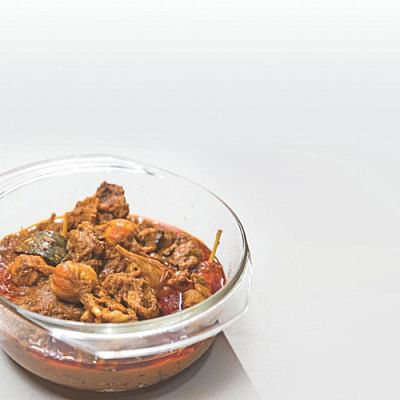
RANGAMATI
At the weekly bazaar that gathers every Saturday and Wednesday between Khagrachhari and Rangamati, where local herbs such as 'tara' (flavour similar to lemongrass) and fuji (which is a combination of earthy tones, clarified butter, coriander and chilli) are sold.
Farmers arrive on boats, with locally grown varieties of tobacco to sell. Both young and old get together in what almost seems like a tobacco tasting event. The bazaar is colourful and lively as people decide which tobacco to buy. Whatever money the farmers make from the sales is spent on cinema tickets or just having a good time.
Some other herbs grown here are--Sabalang that is similar to sweet basil and Borolipata, which when pressed releases its oils that has an aroma of lemon and clarified butter.
A lot of mushrooms and bananas, beef, oysters and snails are consumed here. They have a kind of corn that comes in two colours; one purple and the other one is a purplish yellow. Sugarcane in this region grows red. Varieties of eggplants of different shapes and colours are also available. They eat a lot of sticky rice that comes in different colours — white, red and even dark purple!
Amongst the many kinds of food that they prepare using bamboo, they have a specific dish that they use as spice known as 'nappi.' It is a special fish blend made from smaller fish that get caught in fishing nets and is buried in earthen pots for set periods of time. When taken out, they look like fish cakes and are cut into pieces and then used.
Semi-ripened papaya are cut into small pieces and nappi and tamarind are added and the combination served as a salad.
They not only barbecue meat in bamboo shoots, but also prepare an egg dish in it by wrapping a raw egg with herbs and cooking it; even the sweet curd that they make with jaggery is prepared in bamboo shoots.
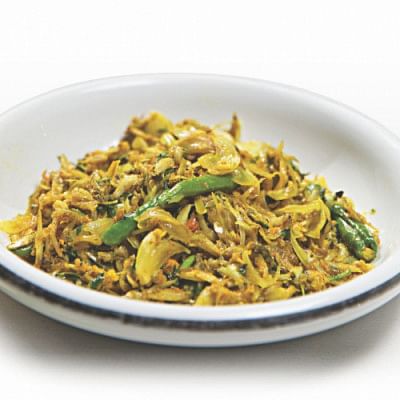
BANDARBAN
They love their barbecues,be it beef or pork, and the recipes for marinating are usually quite simple, as they use some lemon, ginger, chilli and salt for seasoning, crushed together.
CHITTAGONG
When I think of this place, my mind quickly remembers the last time I had 'kala bhuna,' shutki or even mejbani. As the conversation between us progresses, words such as 'do machha, lakhha shutki, chhuri shutki, loitta maach' surface. And the truth is that food wise— shutki, seafish, and beef are probably the closest way to describe Chittagong's cuisine. During religious festivals, beef is cooked in large batches and everyone is invited, from beggars to their wealthy counterparts. This preparation of beef is known as 'mejban' and follows the philosophy of “ain, boin, khain” (all are welcome to sit and have a meal).
The main spices in mejbani include, mustard paste, poppy seed paste (posto), ginger, garlic, garam masala and jeera, just to name a few.
Khaishha is another dish made with seeds of string beans and shutki.
There are also a lot of Burmese influences like 'chow chow' a dessert made with coconut milk.
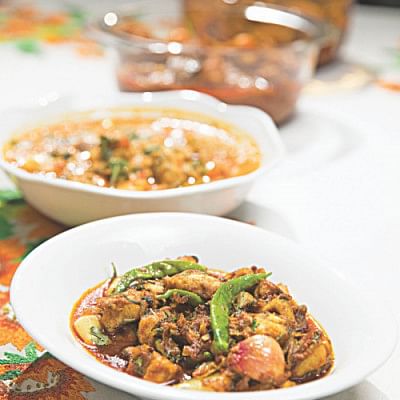
BARISAL
In Nahid Osman's words, “Barisal can be considered as the Venice of Bangladesh because of all the rivers interlacing the district,” and therefore there is an abundance of fish, both sweet water and saltwater variants, due to their proximity to the sea.
On the Bhimrole River, lies a floating guava market that can be dated back to 250-300 years in time. Coconut is a staple in this region, aside from paanchphoron, mustard paste and poppy seed paste. Coconut is also used in many forms including a spice. According to the renowned culinary expert, “Prawn malai-curry originated from Barisal!”
People in this region cook hilsa in a mustard sauce or as a part of a polao dish called 'ilishpulao.' They consume mutton and duck and taro too is also cooked in a coconut curry sauce. They especially love ‘Bombaya’ chillies, and eat it with everything.
In Patuakhali, they make shingaras stuffed with potatoes and pieces of deseeded Bombaya chillies.
Chotpoti is served with the humble, but not so mild chilli, and chicken, with tamarind chutney on the side.
When it comes to sweets, residents of this district have quite the sweet-tooth. They make pickles and candied fruits, morobbas, out of mangoes, wax gourd, pumpkin, and even betel nut (supari)! They prepare pudding using the juice of ripe jackfruits and mangoes.
Nahid Osman talks about one of her favourite pithas from Barisal, 'dudhkhejuri'. Rice flour is boiled in coconut milk until it has a doughy texture, and then a little bit of coconut paste is added. Banana leaves are separated from their stems and then the dough is pressed and rolled out in small amounts onto the ridges of the banana leaf and fried in clarified butter or oil. They are then soaked overnight in jaggery sauce and served.
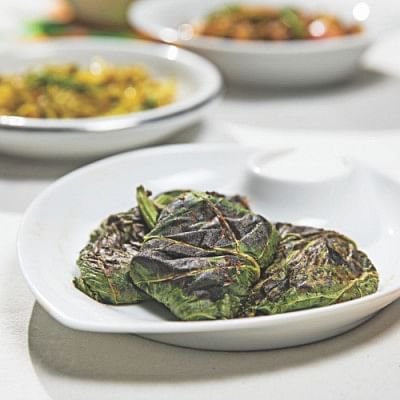
KHULNA
Choi jhaal is a herb found in Khulna, and the roots and stem of the choi shrub have a taste very similar to wasabi. It is often used in mutton and beef dishes. A lot of fish is farmed here; seafood like crab make regular appearances in the food scene as well.
BHOLA
The food consumed here is very similar to the other divisions, but Bhola's specialty is a curd made from buffalo's milk that tastes very close to cheese.
BOGURA
Mahasthangarh's food is influenced heavily by the Hindu Zamindars that once ruled over this place, for which reason, they primarily eat a lot of vegetables like sajna, potatoes, khichuri. 'Alubori', (which are small sun dried dumplings made with pulses and potatoes) are also cooked with in vegetable dishes with sajna. But they also have Mughal influences and love to eat polao, korma and roast.
Bogura to this day is still considered to have the best sweet curd and it is simply known as “Bagurar doi.”
One such Mughal inspired dish is 'lebu daal,' which is made by boiling masur daal and straining it, using a fine cotton cloth separating the thick liquid like cream from the pulses.
A little bit of water is then added to dilute the liquid and chilli, garlic and ginger paste is mixed into the thick concoction for flavouring. As it thickens further, hot ghee is poured in and then slices of paneer and fragrant lemons are added.
DINAJPUR
As famous as the district is for their lychees, they do prepare one of a kind mutton/beef dishes using unripe jackfruits, called 'echor.' Their love for vegetables and pulses is endless, and the region is home to recipes that use sajna as well as its leaves and make different kinds of boris using white gourd.
The use of spices here is similar to Rangpur as they also use paanchphoron, jeera and radhuni, a spice, in most of their dishes.
RANGPUR
There are two dishes that stand out from this region, 'Roshun mangsho' and 'Sholkapolka.' As the name suggests, the first one is made with pods of garlic and mutton, whilst the latter uses an array of greens; leaves of different plants such as sajna, taro, bottle gourd, and a local spinach known as lafra. Chopping the leaves is an art on its own. It is cooked with rice flour and shidol shutki.
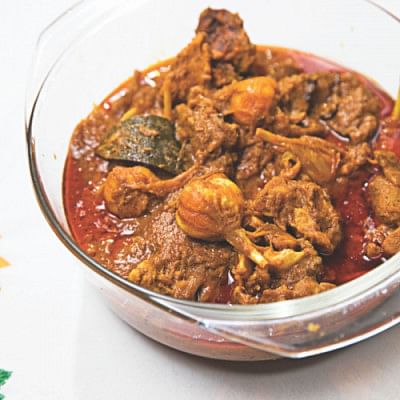
RAJSHAHI
They take their love for sweets very seriously– in fact everything they cook has to have a sweet aftertaste to it. Rajshahi mangoes are all the rage so it should come as no surprise that it highlights itself in almost all curries during summer as well as desserts such as rice pudding.
The ‘teel-er khajas’ found here have quite the reputation too.
The mighty Padma flows through this district, so hilsa or locally known as 'Padma'r Ilish' is consumed a lot and served in a tomato and potato sauce.
But the one dish that Nahid Osman felt had etched itself in her memories was the staple dish of kalai-ruti that is served with a mashed brinjal preparation (begun bharta; made by burning the eggplant, adding chillies and onions, and drizzled with mustard oil right before it is served) in Chapai Nawabganj.
Kalai-ruti itself is bland and does not complement chicken curries as much as it does the bharta. The blending of flavours is one that Nahid Osman described as 'heavenly'. Although the mixture for the kalai-ruti dough is readily available in the local markets of Chapai Nawabganj, its primary ingredient is rice flour and kalai daal flour with salt and water.
The ruti is then cooked in three stages on three different earthen flat stoves.
JAMALPUR
Different kinds of eggplants are farmed and consumed in this region. In fact, people also add it to their hilsa curry dishes as well.
White eggplants are grown here that resemble tennis balls, and are cut 1-1½ inches thick and marinated for 15-20 minutes with onion, turmeric, garlic and chilli pastes, coriander, cumin, clarified butter, and mustard oil. It is then cooked by increasing and decreasing the heat and then served.
They consume a lot of fresh water fish and prawn. Interestingly, this region chooses to fry their fish first before adding it to the sauce. They love chapa shutki and even have a recipe for a shutki bharta preparation that does not include oil, just some jackfruit seeds, lau shak and potatoes that are all mixed with spices and kept in earthen pots.
Another dish includes taking chapa shutki bhorta wrapped in leaves and frying those. They also make a unique set of savoury pithas using chapa shutki, sesame seeds, bananas and the like. Chitoi pitha is given a spicy edge. Chhita-ruti, which is a specialty of the region, is almost dosa-like and made with ginger, garlic, onion and cumin paste, and served with a desi styled scrambled egg, or jhaal gosh. But nothing comes close to 'handesh,' a kind of pitha made with rice flour and beef, which almost has a halim-like consistency.
COMILLA
Vegetables grown in this district have a unique taste, and they are widely used in a lot of dishes in the region. Fish is also very popular, which is cooked in a very thin sauce, which is also a Comilla specialty.
People of Comilla also have an affinity towards chapa shutki, making it from puti maach and burying them in earthen pots for long periods of time. According to Nahid Osman, “This form of shutki is also popular in Sylhet and Brahmanbaria, and anyone who has ever tasted this will become a lover for life!”
Shutki patori is iconic to the region. The recipe calls for chapa shutki wrapped in white gourd/taro leaves with red chillies and then fried or steamed. Food eaten here is very close to the cuisine found in Agartola.
The sweet shop Matri Bhandarhas has a 400-year-old standing reputation of having the best rasmalai nationwide.
SYLHET
This district can be summed food wise in less than five words, 'tea and citrus fruits'. For Sylhetis, lemon is a must have and local vendors even sell puffed rice mix with chanachur and raw tea leaf bharta. They even have a separate recipe on turning raw tea leaves into a shutki.
The cuisine is very much similar to Khasiya food with a love for shutkis, kaika and fresh fish.
The different varieties of lemon found here include shatkora, which has lemon and cardamom (elachi) tones. Ada zameer is similar to shatkora, but with a stronger cardamom aroma. Their peels are used to cook meat and fish dishes. Beef is consumed a fair bit here, with a slightly higher fat content, which complements these citrus fruits very well. Zara, which has a thick skin but sweet tone, is sometimes made into a pickle.
Binni rice is also used to make a dish called 'choongapura. 'Choonga is the name of bamboo that the rice is cooked in and is served with duck, which is made with bamboo shoots. During Ramadan, Iftar is always a tehari made with chhola and eaten with peyaju. They also have a yellow rice, which is quite fragrant.
BIKRAMPUR AND FARIDPUR
Located on either side of Padma, these two regions, are also home to the famed Padma'r Ilish.
People here consume koi, shoil, kholla, tapashi and shagorpona, which are very expensive because of their rarity. Fish is not fried beforehand, but rather, cooked in the sauce. Chitol and foli is used to make koftas. Methi shoil is a dish that is cooked without adding any water and only thick slices of onion and fenugreek (methi). Chitoi pitha is eaten with hilsa and a lot of 'mattha' (a buttermilk drink). Kajeer bhaat, which is basically the small amounts of rice that are set aside when cooking rice for everyday meals is allowed to ferment for a few days and then cooked like normal rice, and served with different kinds of bhortas.
The dish is quite commonly cooked during weekend lunches, as it results in quite a good nap-post feast.
Bikrampur in general is also known for having good sweets.
FARIDPUR AND NOAKHALI
While Faridpur is renowned for its jaggery, Noakhali loves its food hot. Kolmi-shaak with daal is a simple, yet an iconic dish of the district.
DHAKA
For this writer, the journey finally ended with a quick but familiar visit to the capital that millions call 'home!'
Dhaka has its gastronomic roots woven tightly around Mughal influences starting from tehari, different kinds of kababs (jali, shami, shutli, and boti), mutton rezala, bakarkhani, nehari, murog musallam, chaap, to our version of biriyani, and of course 'kachhi.' According to Nahid Osman, “Bangladeshis customised the biriyani by adding the iconic potato to it that you will not see in other versions of it.”
Food is not just a representation of culture, but also a part of what makes us unique as individuals. Whatever we grow up eating becomes a part of the kind of food we end up labelling as our 'favourites', or that dish that gives us warm fuzzy feelings of being wrapped up in a blanket on a winter night.
Food not only relinquishes the mortal hunger, but etches memories into the very soul, waiting to become stories and traditions for the coming generations to grow up on.
Food prepared by: Nahid Osman
To watch the companion videos, visit The Daily Star's official YouTube Channel and Star Lifestyle's Facebook page.

 For all latest news, follow The Daily Star's Google News channel.
For all latest news, follow The Daily Star's Google News channel. 



Comments